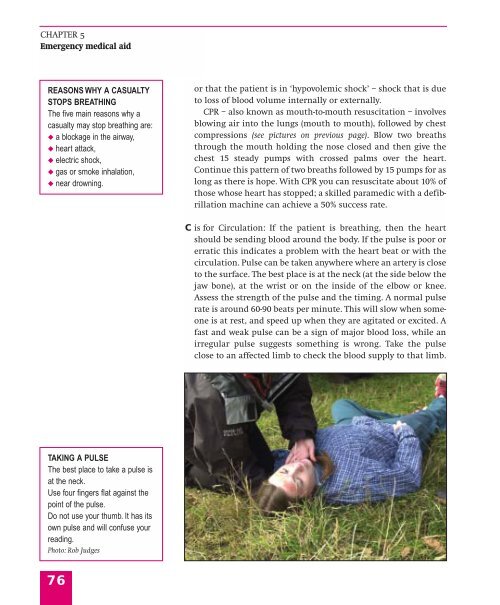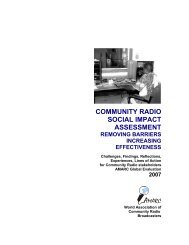Live News - A Survival Guide - International Federation of Journalists
Live News - A Survival Guide - International Federation of Journalists
Live News - A Survival Guide - International Federation of Journalists
- No tags were found...
Create successful ePaper yourself
Turn your PDF publications into a flip-book with our unique Google optimized e-Paper software.
CHAPTER 5Emergency medical aidREASONS WHY A CASUALTYSTOPS BREATHINGThe five main reasons why acasualty may stop breathing are:◆ a blockage in the airway,◆ heart attack,◆ electric shock,◆ gas or smoke inhalation,◆ near drowning.or that the patient is in ‘hypovolemic shock’ – shock that is dueto loss <strong>of</strong> blood volume internally or externally.CPR – also known as mouth-to-mouth resuscitation – involvesblowing air into the lungs (mouth to mouth), followed by chestcompressions (see pictures on previous page). Blow two breathsthrough the mouth holding the nose closed and then give thechest 15 steady pumps with crossed palms over the heart.Continue this pattern <strong>of</strong> two breaths followed by 15 pumps for aslong as there is hope. With CPR you can resuscitate about 10% <strong>of</strong>those whose heart has stopped; a skilled paramedic with a defibrillationmachine can achieve a 50% success rate.C is for Circulation: If the patient is breathing, then the heartshould be sending blood around the body. If the pulse is poor orerratic this indicates a problem with the heart beat or with thecirculation. Pulse can be taken anywhere where an artery is closeto the surface. The best place is at the neck (at the side below thejaw bone), at the wrist or on the inside <strong>of</strong> the elbow or knee.Assess the strength <strong>of</strong> the pulse and the timing. A normal pulserate is around 60-90 beats per minute. This will slow when someoneis at rest, and speed up when they are agitated or excited. Afast and weak pulse can be a sign <strong>of</strong> major blood loss, while anirregular pulse suggests something is wrong. Take the pulseclose to an affected limb to check the blood supply to that limb.TAKING A PULSEThe best place to take a pulse isat the neck.Use four fingers flat against thepoint <strong>of</strong> the pulse.Do not use your thumb. It has itsown pulse and will confuse yourreading.Photo: Rob Judges76
















